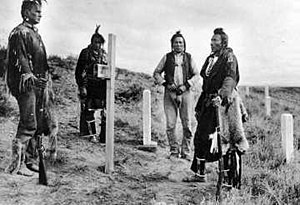| Crow Scouts | |
|---|---|
 Crow scouts visiting the Little Bighorn battlefield, circa 1913. From left to right; White Man Runs Him, Hairy Moccasin, Curly and Goes Ahead. Joseph Medicine Crow explained the main reason for men like these to enlist. They scouted against a long time Indian enemy, "... who were now in the old Crow country, menacing and often raiding the Crows in their reservation camps."[1]: X | |
| Active | 1876 - 1879 |
| Allegiance | |
| Branch | United States Army |
| Type | Indian scouts |
| Engagements | Great Sioux War |
| Commanders | |
| Notable commanders | James H. Bradley, George A. Custer, Nelson A. Miles, Charles A. Varnum |
Crow Scouts worked with the United States Army in several conflicts, the first in 1876 during the Great Sioux War. Because the Crow Nation was at that time at peace with the United States,[2]: xi the army was able to enlist Crow warriors to help them in their encroachment against the Native Americans with whom they were at war. In 1873, the Crow called for U.S. military actions against the Lakota people they reported were trespassing into the newly designated Crow reservation territories.[3]: 106
A small group of Crow scouts had witnessed General George A. Custer's defeat at the Battle of the Little Bighorn in the Crow reservation. Many Crow fought in the Nez Perce War in 1877,[4]: 55–56 and again in the Bannock War the next year.[4]: 122 Crow scouts rode along with Assiniboine, Bannock and Cheyenne during Colonel Nelson A. Miles search for Sitting Bull north of the Missouri in 1879,[4]: 125 and some former scouts fought in the Crow War of 1887.[5]
- ^ Medicine Crow, Joseph (1939): The Effects of European Culture Contacts upon the Economic, Social, and Religious Life of the Crow Indians. A Thesis Presented to the Faculty of the Department of Anthropology, University of Southern California.
- ^ Medicine Crow, Joseph (1992): From the Heart of the Crow Country. The Crow Indians' own Stories. New York.
- ^ Hoxie, Frederick E. (1995): Parading Through History. The making of the Crow Nation in America, 1805-1935. Cambridge.
- ^ a b c Dunlay, Thomas W. (1982): Wolves for the Blue Soldiers. Indian Scouts and Auxiliaries with the United States Army, 1860-90. Lincoln and London.
- ^ "Archived copy" (PDF). Archived from the original (PDF) on 2012-04-25. Retrieved 2011-11-03.
{{cite web}}: CS1 maint: archived copy as title (link)